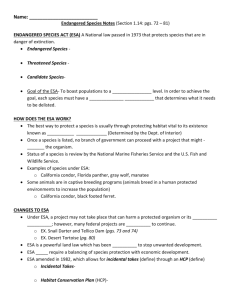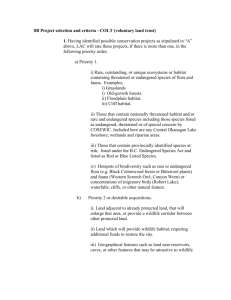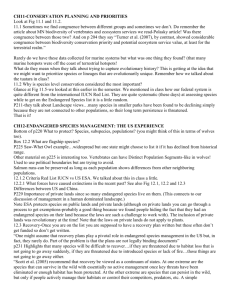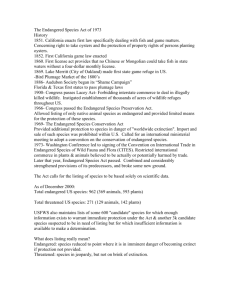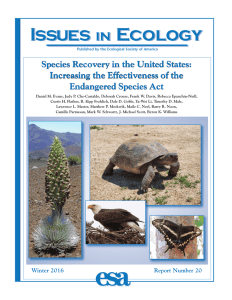Arizona's Natural Resource Conservation Districts 1941-2011
advertisement
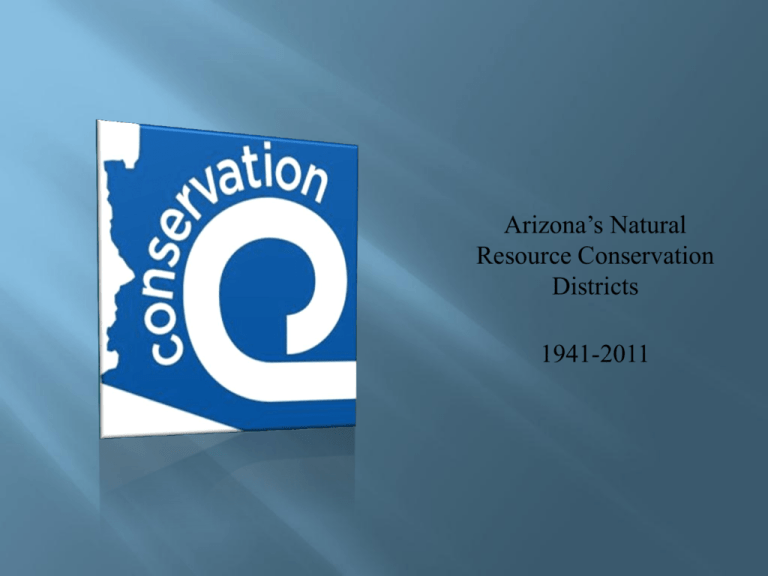
Arizona’s Natural Resource Conservation Districts 1941-2011 On Capitol Hill, while testifying about the erosion problem, soil scientist Hugh Hammond Bennett drew back the curtains to reveal a sky blackened by dust. Congress immediately declared soil and water conservation a national policy and priority. Soil Conservation Service (SCS) created under the Soil Conservation Act of 1935, to develop and implement soil erosion control programs. Locally Led Soil Conservation Boards Standard States District Act Sent to the States for Review and Adoption. Arizona approves Enabling Legislation 1942 – Title 37 Chpt.6 “to provide for the restoration and conservation of lands and soil resources of the state, the preservation of water rights and the control and prevention of soil erosion, and thereby to conserve natural resources, conserve wildlife, protect the tax base, protect public lands and protect and restore this state’s rivers and streams and associated riparian habitats, including fish and wildlife resources that are dependent on those habitats, and in such manner to protect and promote the public health, safety and general welfare of the people.” (ARS Title 37, Chapter 6) Prior to 1966 The Progressive Conservationists Movement is minimal. 1962 Rachel Carson – Silent Spring- Sparks a national environmental movement. 1964 U.S. Fish and Wildlife Service Creates the “Redbook” species known to be threatened with extinction. 1966 Endangered Species Conservation Act Redbook expanded to include threatened species worldwide and expanded the definition of “fish or wildlife”. 1973- The ESA is passed and signed into law by President Nixon -overwhelming supported by both Houses and the public. 1975 – Honeymoon is short-lived and the realization of the power and scope of the Act is realized when the snail darter threatens the construction of Tellico Dam in Tennessee. ESA is not “cost free”. 1978 Amendment- Creates the “God Squad”, critical habitat requirement, and consideration of economic impacts. 1982 Amendment- requirements added to free the logjam created in the 78 Amendment. Added timelines – 90 day findings to list, and relaxed critical habitat timeline for determination. Addressed issues related to ESA’s affect on non-federal property, and added Section 10(exemption permits). 1988 Amendment – Monitoring of Candidate Species, addressed recovery plan priorities – warm and fuzzy vs. cold and slimy. Fish and Wildlife mis-handles the listing petition. Environmental organizations become emboldened by a significant win. Listing Determination (biology vs. economics) Critical Habitat Designation Timber Sales/Section 7/BLM Section 9 Interpretation – Court decision defines “harm” to include habitat modification (Sweet Home vs. Babbit/DOI) ESA Deadlock – Has not been re-authorized since 1992. Executive Order 13563- President Obama “Improving Regulations and Regulatory Review” The Services identify several focus areas for regulatory improvement – efficiency and effectiveness of the ESA. Mapping of critical habitat and designation process, “Significant Portion of its Range” Involvement of States in ESA Implementation and Effectiveness, Clarify the scope and content of the incidental take statement, Clarify, expedite, and improve procedures for the development and approval of conservation agreements with landowners, Incentives for voluntary partnerships with private landowners Clarify the definition of the phrase "destruction or adverse modification” of critical habitat, Administration of FIFRA with the ESA. Wild Earth Guardians: Settlement Agreement Requires the Service to make a final determination on Endangered Species Act status for 252 candidate species by September 2016. Under the agreement the Service would also make findings over the next two years on a suite of citizens’ petitions for imperiled plants and animals. 23 in Arizona 85% will likely be listed (NESARC) A Future For All: A Blueprint for Strengthening the Endangered Species Act Center for Biological Diversity October 2011 “In an effort to help the Obama administration develop a proposal that truly strengthens implementation of the Endangered Species Act, the strongest and most effective law for protecting biodiversity passed by any nation, the Center for Biological Diversity has developed the following set of recommendations…” • • • Voluntary participation of private lands in efforts for species recovery is discouraged by an ESA that punishes first and rewards conditionally. The unrealistic timelines and ambiguous language of the ESA encourages frivolous lawsuits while the petitioning process violates equal protection under the law for all citizens. The ESA has a narrow focus that ignores economic realities and multispecies management. America’s Working Lands: Updating the Endangered Species Act to Ensure Successful Species Recovery and A Productive Future AZ Natural Resource Conservation Districts State Association July 2012 Thorough, Pragmatic, Optimistic “Update and Modernize” “We have much to gain from ensuring the survival of the species of plants and animals that exist in our world today. Simultaneously, we must also consider the benefits we receive from our ability to create and produce the goods that we as humans need to survive: food, clothing, shelter, clean air and water, and the energy and technologies to produce those goods. “ “The ways in which we do this have changed significantly in the past several decades because of this heightened sense of awareness and concern that we as a society have for our environment and the value that we place on clean air, clean water, healthy soils, and abundant wildlife. “ “Many consider the ESA to be the most powerful environmental law ever passed in this country, yet despite its precautionary nature and nearly four decades of aggressive implementation, the results it has produced in terms of species recovery are dismal and warrant change. “ • • • • • • All agency actions in the listing process must be judicially reviewable. There must be more realistic timelines for listing and critical habitat determinations. The best scientific data available must also be reliable, replicable and verifiable. The ESA must not focus on single species management when that approach is counter to natural processes, making recovery of certain species dependent on killing other species (example: Spotted and Barred owls). Listing petitions must have scientific integrity to pass the initial review by the agencies. More transparency of listing decision subject matter is necessary. • • • • It is a societal responsibility to recover a species and the ESA should better reflect this through compensatory programs for landowners to ease the burden on private property. We must replace coercive incentive programs with truly incentive based compensatory programs. Species which are listed and afforded the protections of the ESA should be limited to those species with a majority range within the borders of the United States. We have no control over management in other countries, and at this time in history our budget expenditures are reliant on borrowed dollars. Any foreign efforts only dilute our ability to recover listed species here in the U.S. Presently ambiguous and subjective language must be further defined within the ESA. What flexibility that exists in the ESA is not always reflected in implementation, and reflects federal agency bias. Permitting outside scientific audit and review of listings, recovery plans, and consultations at the request of applicants would provide more accountability to federal agency personnel. • • • In addition to cooperation with state governments, more emphasis needs to be placed on cooperation with local governments. Local governments have jurisdiction over broad based planning and zoning for private lands, where the majority of T&E habitat exists. The burden of species management is disproportionately carried by local economies. Decision makers must be allowed to adapt the management of an ecosystem based upon new information. After almost 40 years, is the current methodology working when less than one-percent of listed species have been “recovered?” Effectiveness of the ESA is dependent upon more oversight and cost/benefit analysis of species listing and recovery. We ask for your support in moving this document forward and thereby moving these issues to the forefront of the Endangered Species Act discussion ….. Congress American Industry Environmental Organizations And Dinner Table of the American Public …..in order that we maintain our place in history as the strongest and most productive nation in the world while conserving our natural resources for future generations.

